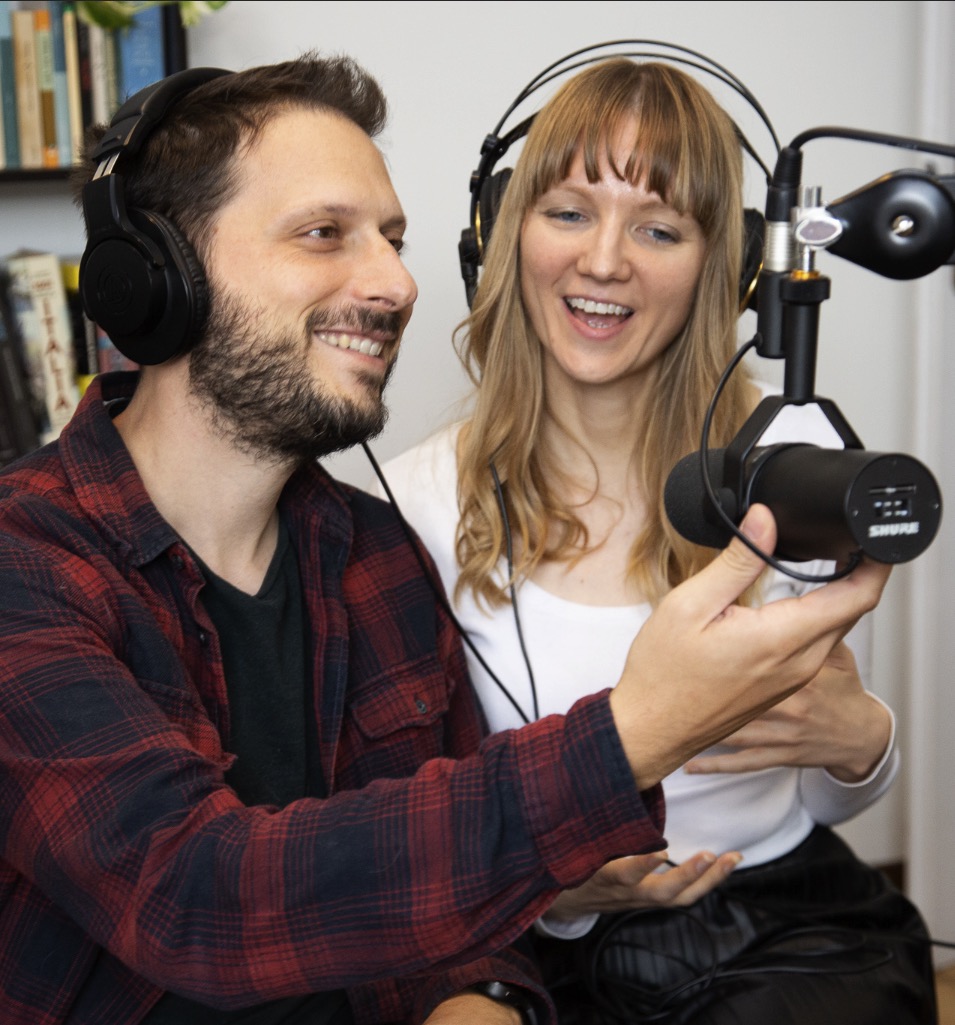I love travelling.
I love jumping on a plane, hopping out the other side and being surrounded by different people, sights, smells and of course, languages.
I even love that awkward feeling of trying to use the lingo with the locals and being met with a confused stare or nervous laugh, because I know it’s the start of something great: if I persevere, I’ll be fluent one day.
Despite this, I’ve done most of my language learning missions without spending long periods of time abroad. Living in a new country sounds exciting, but it's not very practical. I’ve got all kinds of good stuff going on here that I don't want to leave behind, like a relationship, job and friends.
 I love travelling in Spain but I'm can't move there. So I've found a way to become fluent in Spanish from home instead.
I love travelling in Spain but I'm can't move there. So I've found a way to become fluent in Spanish from home instead.
Maybe you’re in a similar situation. You want to learn Spanish, but for work or family or whatever reason, you can’t move to Spain or Latin America to do it. If this sounds like you, I have good news: you don’t need to go abroad to become fluent in Spanish. You can do it from the comfort of your own home, in your fluffy socks. I did something similar back in July, when I decided to become fluent in French from my living room. Now, I’m planning on doing the same thing for Spanish. In this article, I’ll share my step-by-step plan that you can use to become fluent in Spanish without leaving the house. But first...
 I learnt Italian faster in Italy because I spent less time studying grammar rules and more time chatting to Italians. But you don't need to be in the country to do that.
I learnt Italian faster in Italy because I spent less time studying grammar rules and more time chatting to Italians. But you don't need to be in the country to do that.
The good news is, you don’t need to be in the country to do these things. These are situations you can easily recreate at home: I know because I’ve done it with the other languages I’ve learnt. In the next section, I’ll show you how you can apply these ideas to become fluent in Spanish from home.
 I love travelling in Spain but I'm can't move there. So I've found a way to become fluent in Spanish from home instead.
I love travelling in Spain but I'm can't move there. So I've found a way to become fluent in Spanish from home instead.Maybe you’re in a similar situation. You want to learn Spanish, but for work or family or whatever reason, you can’t move to Spain or Latin America to do it. If this sounds like you, I have good news: you don’t need to go abroad to become fluent in Spanish. You can do it from the comfort of your own home, in your fluffy socks. I did something similar back in July, when I decided to become fluent in French from my living room. Now, I’m planning on doing the same thing for Spanish. In this article, I’ll share my step-by-step plan that you can use to become fluent in Spanish without leaving the house. But first...
Why you don’t need to go to the country to learn a language
It seems like every time people start talking about foreign languages, someone tells the story about how the only way to learn a language is to go to the country. Sometimes they’ll give examples of a friend or a family member who went abroad and picked up the language easily because they needed it to survive. But the idea that there’s something magical about being in the country that makes language learning effortless is simply not true. For a start, it’s easy to live in a foreign country without learning the language. Immigrants do it all the time (especially the ones from Western societies who are sometimes referred to as expats). Secondly, if you don’t have a decent command of the language before you get there, you’ll struggle to make friends in the language you’re learning. And if you’re an English speaker, unless you’re going somewhere remote where no one else speaks English, you may have to battle to find opportunities to speak the language, because everyone will want to practice their English with you. The reason some people have more success with languages while living in the country is due to a change in approach, rather than anything special about being in the country. I experienced this firsthand when I moved to Italy. Living in the country changed the way I learnt Italian in two important ways:- I stopped focusing on trying to memorise grammar rules and vocabulary and started using the language to communicate with human beings.
- I spent lots of time practicing speaking.
 I learnt Italian faster in Italy because I spent less time studying grammar rules and more time chatting to Italians. But you don't need to be in the country to do that.
I learnt Italian faster in Italy because I spent less time studying grammar rules and more time chatting to Italians. But you don't need to be in the country to do that.The good news is, you don’t need to be in the country to do these things. These are situations you can easily recreate at home: I know because I’ve done it with the other languages I’ve learnt. In the next section, I’ll show you how you can apply these ideas to become fluent in Spanish from home.
Become fluent in Spanish without leaving the house: A step-by-step guide
Step 1: Define your goal
If your goal is to become fluent in Spanish, you’ll need to decide what that means first. This can be tricky because the word “fluent” is a bit vague. To some people, you’re fluent as soon as you can have a basic conversation. For others, you shouldn’t say you’re fluent until you sound like a native speaker. For me, fluency means being able to function more or less as a native speaker would in everyday situations. This means:- I understand most things I hear (except strong accents, local slang, or specialist vocabulary).
- I can talk quickly and native listeners understand me without straining.
- I rarely have to search for words (unless it’s specialist vocabulary or a momentary slip).
- I probably still make mistakes and have a slight foreign accent, but they don't impede communication.
Step 2: Give yourself a deadline
Your deadline will depend on how much time you can put aside to study each day. If you’re starting from scratch, you could reach this level of fluency in 1 year by studying for 2 - 3 hours per day. If you’re already at an intermediate level, you could get there in about 6 months. If this sounds intense, don’t worry - this doesn’t mean hours of “school-like” studying from grammar books. The better you get at Spanish, the more you’ll be able to fill this time with stuff you really enjoy doing, like chatting to Spanish speakers, reading books/magazines/newspapers or watching TV and films. Learning a language doesn’t have to be boring or stressful. To find out how to enjoy the process, you might find these posts useful: How to learn a language at home (even if you’re really lazy). The 11 easiest languages (and how to make any language easy). Also, remember that by the end of the year, you’ll be fluent in Spanish. It'll take time and effort, but it’ll be so worth it. Once you've got your deadline, break it up into mini goals. This is important because a year feels very far away, which makes it easy to find excuses to keep putting off learning Spanish. Here’s an example of 3 mini goals you could set yourself over the course of the year.- After 3 months: I can have conversations about simple things.
- After 6 months: I can talk comfortably about familiar topics.
- After 12 months: I can speak fluent Spanish (in line with the definition in step 1)
Step 3: Get into a routine
To become fluent in Spanish, decide which actions you’ll need to take each day, then ACTUALLY DO THEM. Forgive me for shouting, but this is the most important bit of the whole guide. You'll need to think about:- How long you’ll study each day.
- When and where you’ll do it.
- What you’ll do in that time.
- Listen to Coffee Break Spanish as you eat your breakfast.
- Review vocabulary using a flashcard app on your phone whilst stuck in traffic or waiting for the train.
- Listen to an audiobook for Spanish learners during your commute.
- After work, you could do a lesson with an online Spanish tutor, study a chapter from a textbook or if you're feeling tired, chill out in front of some YouTube videos like Spanish Extra or Easy Spanish.
- If you feel like going out, you could meet a native Spanish speaker in your area and set up a language exchange at the pub (more on this later).
Step 4: Find your tools
If you’re going to be spending a couple of hours a day learning Spanish, you’ll need to find some fun and useful things to do during that time. Experiment with different resources like textbooks, podcasts and YouTube channels for Spanish learners until you find things you like that help you make progress. Not sure where to find tools for learning Spanish? These articles might help. The 11 best tools for learning Spanish from beginner to advanced The lazy person’s guide to learning Spanish 32 Fun ways to learn a language (that actually work)Step 5: Measure your progress
Learning a language is like watching a plant grow. From day to day, the changes are almost imperceptible. But if you can step back and look at it after a few months, you’ll see that it’s grown loads. Language learning happens so gradually that it can feel like you’re not making progress, which is demotivating. One way to resolve this is to record yourself speaking every now and then so you can look back and notice how far you’ve come. This will show you that your hard work is paying off and give you extra motivation to keep going. To see what I mean, check out what happened when I recorded my progress in German over 3 months. Day to day, I felt like I was getting nowhere, but when I compared day 1 with day 90, I was quite pleased with how much I'd learnt. https://www.youtube.com/watch?time_continue=1&v=yHHUaPkwEYo [embed][/embed]Step 6: Find your people
One reason learning a language in the country seems easier than learning in the classroom is that it transforms a boring school subject into a way to communicate with other human beings. Instead of studying to pass a test, you’re learning Spanish so you can chat to your mate Carlos about a girl he met last weekend. The more you can see Spanish as means of connecting with people, the more motivated you’ll be and the faster you’ll learn. But how can you do this without living in the country? You can take advantage of this newfangled technology called the “Internet”, which allows you to connect with Spanish speaking people on the other side of the planet, from the comfort of your living room. This tool, which has revolutionalised language learning, is your most important ally in your quest to become fluent in your Spanish without putting pants on. I use fab website called italki, where you can find loads of native Spanish tutors waiting to talk to you on Skype for a very reasonable price. Just this week I’ve had lovely chats with María from Venezuela and Carlos from Mexico for less than $10 an hour. If you fancy giving it a go, click on any of the italki links on this page - you'll to get a free $10 dollar voucher after your first lesson. For tips on where to start, check out this tutorial italki: How to learn a language with an online tutor Alternatively you prefer a completely free option, you can also use italki to set up a language exchange with Spanish speakers who want to learn your language: this way you can talk for half the time in your native language and the other half in Spanish (just make sure you’re strict about the 50/50 rule right from the beginning, so your partner doesn’t hijack your Spanish speaking time!) Alternatively, if you’d rather make real flesh and blood friends, you can use the internet to find Spanish speaking people in your area. Conversation exchange is a great website for this. If the idea of speaking Spanish makes you feel nervous, you might find this article useful: What’s stopping you from speaking a foreign language (and how to fix it)Step 7: Talk as much as possible
Grammar exercises and language learning apps might make you feel like you’re doing something useful, but the best (and most enjoyable) way to learn how to speak a language is by talking to people. The more you practice speaking, the more fluent you’ll be. Simple as that. Whether you pay tutors for online conversation lessons, or set up language exchanges, make it your priority to find people you enjoy spending time with and practice speaking Spanish with them as much as possible. Once you do this, becoming fluent in Spanish is just a matter of time.My plan to become fluent in Spanish
Next, I’ll explain how I’m going to apply these ideas to help me become fluent in Spanish from my living room.Set a goal + deadline
I’m already at an intermediate level in Spanish, so I’m going to give myself 6 months to become fluent.Get into a routine
I’m aiming to learn Spanish for 2 hours a day over the next 6 months. As I’ve just finished my French mission, I already have a routine that sets 2 hours aside for language learning, so I just need to switch the language from French to Spanish. However, if I was building a routine from scratch, I’d start very small, say 5 minutes per day, and increase the time gradually using the technique I discussed in step 3. Here’s a list of things I'm planning to do integrate into my Spanish learning routine:- Watch Spanish CNN while I eat breakfast and drink coffee.
- Write a daily diary in Spanish.
- Do at least 3 conversation lessons per week with my Spanish tutors on Skype (via italki).
- Learn 200 words per month (about 6 per day) on my Flashcard app. To find out how I use flashcards to learn vocabulary, check out this post on how to remember words in a foreign language.
- Listen to Spanish podcasts while I’m going about my day.
- Integrate Spanish into my downtime. 2 hours a day is a lot, and if it felt like work all the time I’d never manage to keep it up. For this reason, I’m going to include lots of fun activities I can do in my downtime, like audiobooks, Spanish-language TV series on Netflix, TedTalks in Spanish, dancing around the house like a crazy lady and singing along to Cypress Hill in Spanish...




